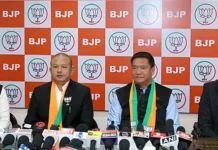[ Tongam Rina ]
TAWANG, 1 Nov: Dawa Tsering from Jang is a 17-year-old and one of 48 singers aspiring to win Mon Sergelling, a hugely popular singing contest keenly followed not only in the Mon region of West Kameng and Tawang but also beyond.
Motivated by his older brother, Pasang Tsering, he successfully auditioned for this year’s competition. The shy, polite boy tells me that he had to brush up on his singing skills in Monpa because he will be required to sing in his mother tongue, as well as in Hindi. It should not be too difficult for Dawa, as Arijit Singh is his favorite Hindi singer, while his favorite genre is Monpa modern songs.
It’s not only Mon Sergelling, which features modern Monpa songs and Hindi songs that captivates listeners; the Mon Rigshung Sergelling, a traditional folk song competition, has also garnered much interest.
The Mon Rigshung Sergelling has been credited with popularizing folk songs among the younger generation and reviving interest among older audiences. “It has helped revive folk songs,” says Tsangpa Norbu, the chairman of the singing competition. Fifteen folk singers are participating in the Mon Rigshung Sergelling, performing Monpa folk songs that are known for being difficult to master and unique. There has been a steady increase in the number of participants.
Norbu, notes that the increase in participation is significant compared to the first season, which had only five contestants. Now, folk singers receive training from the Monpa Institute of Performing Arts (MIPA), and many talented artists have emerged.
The songs performed cover themes of marriage, rituals and life cycles, with dance dramas like Yak Cham and Aji Lhamo showcasing the versatility of the artists.
Spanning over 45 days, there will be 12 episodes, and the singers in both categories are divided into four houses, each with two mentors. There is no public voting; judging is solely by a panel of five acclaimed artists for each of the segments, ensuring no chance of fraudulent votings. Among the judges is Jambey Thutan, a celebrated folk singer.
Now in its fourth season, the competition is held every three years, though there was a gap of a few years due to COVID-19 and elections. The first three seasons were organized by the Film Federation of Monyul, but now the Monpa Artist Forum is responsible for organizing the fourth season at Jung Sports Club. From the 48 contestants, five from each category will advance to the top five, and three from each will enter the grand finale, which promises to be as engaging and crowd-pulling as previous competitions.
The chief minister, Pema Khandu, is the patron of the singing competition and conceived it in an effort to revive folk songs in the Mon region, Norbu informed.
How is this competition different from the dozens of other singing competitions across the state?
Dorjee Gyaltsan, a singer and composer who won the first Mon Sergelling, says that such events are essential for popularizing singing among the younger generation, noting that folk songs are diminishing. “We need to revive the dying folk singing culture,” he says.
Folk albums are being produced as a result of the Mon Rigshung Sergelling, and young people are learning to sing folk songs. Also, the prize money is attractive, says Norbu.
The prize money is 5 lakhs for the winner and 3 and 2 lakhs for the runners-up, along with consolation prizes. It’s not only the prize money that is attractive; some participants of the contest have become household names in the state.
Thupten Tashi has traveled the world performing, and Indian Idol participant Thumpten Tsering is widely popular. Many have also featured in Arunachal Idol.
“It does not matter whether I win or not, but it’s a huge platform to gain exposure and learn from other singers and mentors who have years of experience,” Dawa says. The singing competitions could propel many promising singers like Dawa to stardom and open new opportunities.
They also serve as a platform to engage with tradition and help revive folk singing by making it mainstream among the younger generation.





